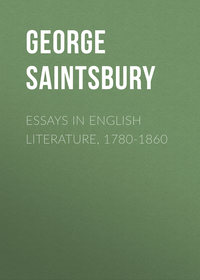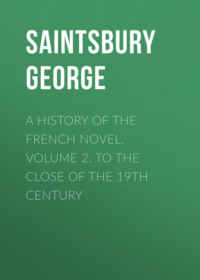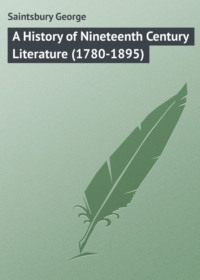 полная версия
полная версияA Short History of French Literature
Here the portion due to William of Lorris ends. Its main characteristics have been indicated by this sketch, except that the extreme beauty and grace of the lavish descriptions which enclose and adorn the somewhat commonplace allegory perforce escape analysis. It is in these descriptions, and in a certain tenderness and elegance of general thought and expression, that the charm of the poem lies, and this is very considerable. The deficiency of action, however, and the continual allegorising threaten to make it monotonous had it been much longer continued in the same strain.
It is unlikely that it was this consideration which determined Jean de Meung to adopt a different style. In his time literature was already agitated by violent social, political, and religious debates, and the treasures of classical learning were becoming more and more commonly known. But prose had not yet become a common literary vehicle, save for history, oratory, and romance, nor had the duty of treating one thing at a time yet impressed itself strongly upon authors. Jean de Meung was satirically disposed, was accomplished in all the learning of his day, and had strong political opinions. He determined accordingly to make the poem of Lorris, which was in all probability already popular, the vehicle of his thoughts.
In doing this he takes up the story as his predecessor had left it, at the point where the lover, deprived of the support of Bel Acueil, and with the suspicions of Dangier thoroughly aroused against him, lies despairing without the walls of the delightful garden. Reason is once more introduced, and protests as before, but in a different tone and much more lengthily. She preaches the disadvantages of love in a speech nearly four hundred lines long, followed by another double the length, and then by a dialogue in which the lover takes his share. The difference of manner is felt at once. The allegory is kept up after a fashion, but instead of the graceful fantasies of William of Lorris, the staple matter is either sharp and satirical views of actual life, or else examples drawn indifferently from sacred and profane history. One speech of Reason's, a thousand lines in length, consists of a collection of instances of this kind showing the mobility of fortune. At length she leaves the lover as she found him, 'melancolieux et dolant,' but unconvinced. Amis (the friend), who has appeared for a moment previously, now reappears, and comforts him, also at great length, dwelling chiefly on the ways of women, concerning which much scandal is talked. The scene with Reason had occupied nearly two thousand lines; that with Amis extends to double that length, so that Jean de Meung had already excelled his predecessor in this respect. Profiting by the counsel he has received, the lover addresses himself to Riches, who guards the way, but fruitlessly. The god of love, however, takes pity on him (slightly ridiculing him for having listened to Reason), and summons all his folk to attack the tower and free Bel Acueil. Among these Faux Semblant presents himself, and, after some parley, is received. This new personification of hypocrisy gives occasion to some of the author's most satirical touches as he describes his principles and practice. After this, Faux Semblant and his companion, Contrainte Astenance (forced or feigned abstinence), set to work in favour of the lover, and soon win their way into the tower. There they find an old woman who acts as Bel Acueil's keeper. She takes a message from them to Bel Acueil, and then engages in a singular conversation with her prisoner, wherein the somewhat loose morality of the discourses of Amis is still further enforced by historical examples, and by paraphrases of not a few passages from Ovid. She afterward admits the lover, who thus, at nearly the sixteen-thousandth line from the beginning, recovers through the help of False Seeming the 'gracious reception' which is to lead him to the rose. The castle, however, is not taken, and Dangier, with the rest of his allegorical company, makes a stout resistance to 'Les Barons de L'Ost' – the lords of Love's army. The god sends to invoke the aid of his mother, and this introduces a new personage. Nature herself, and her confidant, Genius, are brought on the scene, and nearly five thousand verses serve to convey all manner of thoughts and scraps of learning, mostly devoted to the support, as before, of questionably moral doctrines. In these five thousand lines almost all the current ideas of the middle ages on philosophy and natural science are more or less explicitly contained. Finally, Venus arrives and, with her burning brand, drives out Dangier and his crew, though even at this crisis of the action the writer cannot refrain from telling the story of Pygmalion and the Image at length. The way being clear, the lover proceeds unmolested to gather the longed-for rose.
Popularity of the Roman de la Rose.
It is impossible to exaggerate, and not easy to describe, the popularity which this poem enjoyed. Its attacks on womanhood and on morality generally provoked indeed not a few replies, of which the most important came long afterwards from Christine de Pisan and from Gerson. But the general taste was entirely in favour of it. Allegorical already, it was allegorised in fresh senses, even a religious meaning being given to it. The numerous manuscripts which remain of it attest its popularity before the days of printing. It was frequently printed by the earliest typographers of France, and even in the sixteenth century it received a fresh lease of life at the hands of Marot, who re-edited it. Abroad it was praised by Petrarch and translated by Chaucer88; and it is on the whole not too much to say that for fully two centuries it was the favourite book in the vernacular literature of Europe. Nor was it unworthy of this popularity. As has been pointed out, the grace of the part due to William of Lorris is remarkable, and the satirical vigour of the part due to Jean de Meung perhaps more remarkable still. The allegorising and the length which repel readers of to-day did not disgust generations whose favourite literary style was the allegorical, and who had abundance of leisure; but the real secret of its vogue, as of all such vogues, is that it faithfully held up the mirror to the later middle ages. In no single book can that period of history be so conveniently studied. Its inherited religion and its nascent free-thought; its thirst for knowledge and its lack of criticism; its sharp social divisions and its indistinct aspirations after liberty and equality; its traditional morality and asceticism, and its half-pagan, half-childish relish for the pleasures of sense; its romance and its coarseness, all its weakness and all its strength, here appear.
Imitations.
The imitations of the Roman de la Rose were in proportion to its popularity. Much of this imitation took place in other kinds of poetry, which will be noticed hereafter. Two poems, however, which are almost contemporary with its earliest form, and which have only recently been published, deserve mention. One, which is an obvious imitation of Guillaume de Lorris, but an imitation of considerable merit, is the Roman de la Poire89, where the lover is besieged by Love in a tower. The other, of a different class, and free from trace of direct imitation, is the short poem called De Venus la Déesse d'Amors90, written in some three hundred four-lined stanzas, each with one rhyme only. Some passages of this latter are very beautiful.
Three extracts, two from the first part of the Roman de la Rose, and one from the second, will show its style: —
En iceli tens déliteus,Que tote riens d'amer s'esfroie,Sonjai une nuit que j'estoie,Ce m'iert avis en mon dormant,Qu'il estoit matin durement;De mon lit tantost me levai,Chauçai-moi et mes mains lavai.Lors trais une aguille d'argentD'un aguiller mignot et gent,Si pris l'aguille à enfiler.Hors de vile oi talent d'aler,Por oïr des oisiaus les sonsQui chantoient par ces boissonsEn icele saison novele;Cousant mes manches à videle,M'en alai tot seus esbatant,Et les oiselés escoutant,Qui de chanter moult s'engoissoientPar ces vergiers qui florissoient,Jolis, gais et pleins de léesce.Vers une rivière m'adresceQue j'oï près d'ilecques bruire.Car ne me soi aillors déduirePlus bel que sus cele rivière.D'un tertre qui près d'iluec ièreDescendoit l'iaue grant et roide,Clere, bruiant et aussi froideComme puiz, ou comme fontaine,Et estoit poi mendre de Saine,Mès qu'ele iere plus espandue.Onques mès n'avoie véueTele iaue qui si bien coroit:Moult m'abelissoit et séoitA regarder le leu plaisant.De l'iaue clere et reluisantMon vis rafreschi et lavé.Si vi tot covert et pavéLe fons de l'iaue de gravele;La praérie grant et beleTrès au pié de l'iaue batoit.Clere et serie et bele estoitLa matinée et atemprée:Lors m'en alai parmi la préeContreval l'iaue esbanoiant,Tot le rivage costoiant.* * * * * *Une ymage ot emprès escrite,Qui sembloit bien estre ypocrite,Papelardie ert apelée.C'est cele qui en recelée,Quant nus ne s'en puet prendre garde,De nul mal faire ne se tarde.El fait dehors le marmiteus,Si a le vis simple et piteus,Et semble sainte créature;Mais sous ciel n'a male aventureQu'ele ne pense en son corage.Moult la ressembloit bien l'ymageQui faite fu à sa semblance,Qu'el fu de simple contenance;Et si fu chaucie et vestueTout ainsinc cum fame rendue.En sa main un sautier tenoit,Et sachiés que moult se penoitDe faire à Dieu prières faintes,Et d'appeler et sains et saintes.El ne fu gaie ne jolive,Ains fu par semblant ententiveDu tout à bonnes ovres faire;Et si avoit vestu la haire.Et sachiés que n'iere pas grasse.De jeuner sembloit estre lasse,S'avoit la color pale et morte.A li et as siens ert la porteDévéée de Paradis;Car icel gent si font lor visAmegrir, ce dit l'Évangile,Por avoir loz parmi la vile,Et por un poi de gloire vaine,Qui lor toldra Dieu et son raine.* * * * * *Comment le traistre Faulx-SemblantSi va les cueurs des gens emblant,Pour ses vestemens noirs et gris,Et pour son viz pasle amaisgris.'Trop sai bien mes habiz changier,Prendre l'un, et l'autre estrangier.Or sui chevaliers, or sui moines,Or sui prélas, or sui chanoines,Or sui clers, autre ore sui prestres,Or sui desciples, or sui mestres,Or chastelains, or forestiers:Briément, ge sui de tous mestiers.Or resui princes, or sui pages,Or sai parler trestous langages;Autre ore sui viex et chenus,Or resui jones devenus.Or sui Robers, or sui Robins,Or cordeliers, or jacobins.Si pren por sivre ma compaigneQui me solace et acompaigne,(C'est dame Astenance-Contrainte),Autre desguiséure mainte,Si cum il li vient à plesirPor acomplir le sien désir.Autre ore vest robe de fame;Or sui damoisele, or sui dame,Autre ore sui religieuse,Or sui rendue, or sui prieuse,Or sui nonain, or sui abesse,Or sui novice, or sui professe;Et vois par toutes régionsCerchant toutes religions. Mès de religion, sans faille,G'en pren le grain et laiz la paille;Por gens avulger i abit,Ge n'en quier, sans plus, que l'abit.Que vous diroie? en itel guiseCum il me plaist ge me desguise;Moult sunt en moi mué li vers,Moult sunt li faiz aux diz divers.Si fais chéoir dedans mes piégesLe monde par mes priviléges;Ge puis confesser et assoldre,(Ce ne me puet nus prélas toldre,)Toutes gens où que ge les truisse;Ne sai prélat nul qui ce puisse,Fors l'apostole solementQui fist cest establissementTout en la faveur de nostre ordre.'CHAPTER VIII
ROMANS D'AVENTURES
Distinguishing features of Romans d'Aventures.
The remarkable fecundity of early French literature in narrative poetry on the great scale was not limited to the Chanson de Geste, the Arthurian Romance, and the classical story wrought into the likeness of one or the other of these. Towards the end of the twelfth or the beginning of the thirteenth century a new class of narrative poems arose, derived from each and all of these kinds, but marked by important differences. The new form immediately reacted on the forms which had given it birth, and produced new Chansons de Gestes, new Arthurian Romances, and new classical stories fashioned after its own image. This is what is called the Roman d'Aventures, of which the first and main feature is open and almost avowed fictitiousness, and the second the more or less complete abandonment of any attempt at cyclic arrangement or subordination to a central theme.
Looser application of the term.
Classes of Romans d'Aventures.
Until quite recently it was not unusual to apply the term Roman d'Aventures with less strictness, and to make it include the Romances of the Round Table. There can, however, be no doubt that it is far better to adopt Jean Bodel's three classes as distinguishing into separate groups the epic poetry of the eleventh and twelfth centuries, and to restrict the title Romans d'Aventures to the later narrative developments of the thirteenth and fourteenth. For the second distinguishing mark which we have just indicated is striking and of more or less universal application. In these later poems the ambition of the writer to class his work under and with some precedent work is almost entirely absent. He allows himself complete freedom, though he may sometimes, in order to give his characters greater interest, connect them nominally with some famous personage or event of the earlier cycles. This tendency to shake off the shackles of cyclicism is early apparent. There are episodes even in the Chansons de Gestes which have little or no reference to Charlemagne or his peers: the Arthurian Romances in prose and verse contain long digressions, holding but very loosely to the Table Round, such as the adventures of Tristram and Percivale, and still more the singular episode of Grimaud in the Saint Graal. As for the third class, the Trouvères almost from the beginning assumed the greatest licence in their handling of the classical legends. These accordingly were less affected than any others by the change. It is possible to divide the Romans d'Aventures themselves under the three headings. It is further possible to indicate a large class of Chansons de Gestes over which the influence of the Roman d'Aventures has passed. But the Chanson having a special formal peculiarity – the assonanced or rhymed tirade – survived the new influence better than the other two, and keeps its name, and to some extent its character, while the Romances of Arthur and antiquity are simply lost in the general body of tales of adventure. These tales are for the most part written in octosyllabic couplets on the model of Chrestien, but a very few, such as Brun de la Montaigne, imitate the exterior characteristics of the Chanson.
It is further to be noticed that while the earlier poems are mostly anonymous, the Romans d'Aventures are generally, though not always, signed, and bear characteristics of particular authorship. In some cases, notably in those of Adenès le Roi and Raoul de Houdenc, we have a body of work signed or otherwise identified, which enables us to attribute a definite literary character and position to its authors. This, as we have noted, is impossible in the case of the national epics, and not too easy in that of the Arthurian Romances. Until quite recently however the Roman d'Aventures has had less of the attention of editors than its forerunners, and the works which compose the class are still to some extent unpublished.
Adenès le Roi.
Adenès or Adans le Roi perhaps derived his surname from the function of king of the minstrels, if he performed it, at the court of Henry III, duke of Brabant. He was, most likely, born in the second quarter of the thirteenth century, and the last probable allusion to him which we have occurs in the year 1297. The events of his life are only known from his own poems, and consist chiefly of travels in company with different princesses and princes of Flanders and Brabant. His literary work is however of great importance. It consists partly of refashionings of three Chansons de Gestes, Les enfances Ogier, Berte aus grans Piés, and Bueves de Commarchis91. In these three poems Adenès works up the old epics into the form fashionable in his time, and as we possess the older versions of the first and last, the comparison of the two forms affords a literary study of the highest interest. His last, longest, and most important work is the Roman d'Aventures of Cléomadès92, a poem extending to 20,000 verses, and not less valuable for its intrinsic merit than as a type of its class. Its popularity in the middle ages was immense. Froissart gives it the place occupied in the Inferno by Lancelot in his description of his declaration of love to his mistress, and allusions to it under its second title of Le Cheval de Fust93 are frequent. The most prominent feature in the story is the introduction of a wooden horse, like that known to everybody in the Arabian Nights, which, started and guided by means of pegs, transports its rider whithersoever he will. Its great length allows of a very long series of adventures, all of which are told in spirited and flowing verse, though with considerable prolixity and a certain abuse of stock descriptions. These two faults characterise all the Romans d'Aventures and the Chansons which were remodelled in their style. The merits of Cléomadès are not so universally found, but its extreme length is not common. Few other Romans d'Aventures exceed 10,000 lines. An extract from this poem will well illustrate the manner of this important class of composition: —
Cleomadés vit un chastelencoste un plain, tres fort et bel,ou il ot mainte bele tour.bos et rivieres vit entour,vignes et praieries grans.mult fu li chastiaus bien sëans.la façon dou castel deïsse,mais je dout mult que ne meïssetrop longement au deviser:pour ce m'en voel briément passer.Du chastel vous dirai le non:miols sëant ne vit aine nus hom,lors l'apieloit on Chastel-noble.n'ot tel dusque en Constantinoble,ne de la dusque en Ostericen'ot plus bel, plus fort ne plus rice.carmans a cel point i estoitque Cleomadés vint la droit.forment li sambloit li chastiausde toutes pars riches et biaus.Cleomadés lors s'avisaque viers le chastel se trera.bien pensoit qu'en tel liu manoientgent qui de grant afaire estoient.che fu si qu'apriés l'ajourneemult faisoit bele matinee,car mais estoit nouviaus entrés:c'est uns tans ki mult est améset de toutes gens conjoïs;pour çou a non mais li jolis.une tres grant tour haute et forteavoit asés priés de la porte,ki estoit couverte de plon,plate deseure, car adonles faisoit on ensi couvrirpour engins et pour assallir.Cleomadés a aviseela tour ki estoit haute et lee;lors pense qu'il s'aresterasor cele tour tant qu'il savra,se il puet, la certainitéquel païs c'est la verité.lors a son cheval adrechiéviers la tour de marbre entaillié.les chevilletes si tournaque droit sour la tour aresta.si coiement s'est avalésque sour aighe coie vait nés.Raoul de Houdenc.
Raoul de Houdenc is an earlier poet than Adenès, and represents the Roman d'Aventures in its infancy, when it still found it necessary to attach itself to the great cycle of the Round Table. His works, besides some shorter poems94, consist of the Roman des Eles (Ailes), a semi-allegorical composition, describing the wings and feathers of chivalry, that is to say, the great chivalrous virtues, among which Raoul, like a herald as he was, gives Largesse the first place; of Méraugis de Portlesguez, an important composition, possessing some marked peculiarities of style; and possibly also of the Vengeance de Raguidel, in which the author works out one of the innumerable unfinished episodes of the great epic of Percevale. Thus Raoul de Houdenc occupies no mean place in French literature, inasmuch as he indicates the starting-point of two great branches, the Roman d'Aventures and the allegorical poem, and this at a very early date. This date is not known exactly; but it was certainly before 1228, when the Trouvère Huon de Méry alludes to him, and classes him with Chrestien as a master of French verse. He has in truth some very noteworthy peculiarities. The chief of these, which must soon strike any reader of Méraugis, is his tendency to enjambement or overlapping of couplets. It is a curious feature in the history of French verse that the isolation of the couplet has constantly recurred in its history, and that as constantly reformers have striven to break up the monotony so produced by this process of enjambement. Perhaps Raoul is the earliest who thus, as an indignant critic put it at the first representation of Hernani, 'broke up verses, and threw them out of window.' Besides this metrical characteristic, the thing most noteworthy in his poems (as might indeed have been expected from his composition of the Roman des Eles) is a tendency to allegorising, and to scholastic disquisitions on points of amatory casuistry. The whole plot of Méraugis indeed turns on the enquiry whether physical or metaphysical love is the sincerest, and on the quarrel which a difference on this point brings on between the hero and Gorvein Cadrus his friend and his rival in the love of the fair Lidoine.
Chief Romans d'Aventures.
Many other Romans d'Aventures deserve mention, both for their intrinsic merits and for the immense popularity they once enjoyed. Foremost among these must be mentioned Partenopex de Blois95 and Flore et Blanchefleur96. The former (formerly ascribed to Denis Pyramus and now denied to him, but said to date from the twelfth century) is a kind of modernised Cupid and Psyche, except that Cupid's place is taken by the fairy Melior, and Psyche's by the knight Parthenopeus or Parthenopex. This poem has great elegance and freshness of style, and though the author is inclined to moralise (as a near forerunner of the Roman de la Rose was bound to do), his moralisings are gracefully and naively put. Flore et Blanchefleur is perhaps even superior. Its theme is the love of a young Christian prince for a Saracen girl-slave, who has been brought up with him. She is sold into a fresh captivity to remove her from him, but he follows her and rescues her unharmed from the harem of the Emir of Babylon. The delicacy of the handling is very remarkable in this poem, and it has some links of connection with Aucassin et Nicolette. Le Roman de Dolopathos97 has a literary history of great interest which we need not touch upon here. Its versification has more vigour than that of almost any other Roman d'Aventures. Blancandin et l'Orguilleuse d'Amour98 is more promising at the beginning than in the sequel. A young knight, hearing of the pride and coyness of a lady, accosts and kisses her as she rides past with a great following of knights. Her coldness is of course changed to love at first sight, and the audacious suitor afterwards delivers her from her enemies; but the working out of the story is rather dully managed. Brun de la Montaigne99, as has been already mentioned, is written in Chanson form, and deals with the famous Forest of Broceliande in Britanny. Guillaume de Palerne100 is a still more interesting work. It introduces the favourite mediaeval idea of lycanthropy, the hero being throughout helped and protected by a friendly were-wolf, who is before the end of the poem freed from the enchantment to which he is subjected. This Romance was early translated into English. Of the same class is the Roman de l'Escouffle, where a hawk carries away the heroine's ring, as in a well-known story of the Arabian Nights. Amadas et Idoine101 is one of the numerous histories of the success of a squire of low degree, but is distinguished from most of them by the originality of its conception and the vigour of its style. The scenes where the hero is recovered of his madness by his beloved, and where, keeping guard over her tomb, he fights with ghostly enemies, after a time of trial of his fidelity, and rescues her from death, are unusually brilliant. Le Bel Inconnu102, which (from a curious misunderstanding of its older form Li Biaus Desconnus) occurs in English form as Lybius Diasconus, tells the story of a son of Gawain and the fairy with the white hands, and thus is one of the numerous secondary Romances of the Round Table. So also is the long and interesting Roman du Chevalier as Deux Espées103; this extends to more than 12,000 lines, and, though the adventures recorded are of the ordinary Round Table pattern, there is noticeable in it a better faculty of maintaining the interest and a completer mastery over episodes than usual. A still longer poem (also belonging to what may be called the outer Arthurian cycle) is Durmart le Gallois104, which contains almost 16,000 verses. The loves of the hero and Fenise, the Queen of Ireland, are somewhat lengthily handled; but there are passages of merit, especially one most striking episode in which the hero, riding through a forest by night, comes to a tree covered from top to bottom with burning torches, while a shining naked child is enthroned on the summit. These touches of mystical religion are rarer in the later Romans d'Aventures than in the Arthurian Romances proper, but with them one of the most remarkable elements of romance disappears. Philippe de Rémy, Seigneur de Beaumanoir (who has other claims to literary distinction) is held to be author of two Romans d'Aventures105, La Manekine (the story of the King of Hungary's daughter, who cut off her hand to save herself from her father's incestuous passion) and Blonde d'Oxford, where a young French squire carries off an English heiress. Joufrois de Poitiers106, which has not come down to us complete, is chiefly remarkable for the liveliness of style with which adventures, in themselves tolerably hackneyed, are handled. Other Romans d'Aventures, which are either as yet in manuscript or of less importance, are Ille et Galeron and Eracle, both by Gautier d'Arras, Cristal et Larie, La Dame à la Licorne, Guy de Warwike, Gérard de Nevers or La Violette107, Guillaume de Dole, Elédus et Séréna, Florimont.










